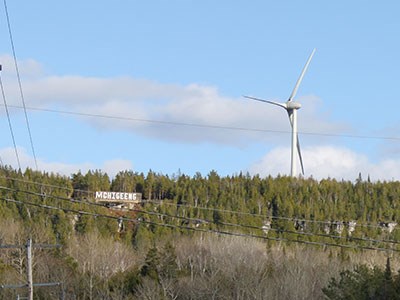Wind generation hasn’t been an easy proposition for the Mother Earth Renewable Energy (MERE) project. In its first year of operation, the $12.5-million, 4-megawatt wind turbine project run by the M’Chigeeng First Nation encountered more than a few snags that held up production. From a delay in receiving its certificate to operate to power surges to communication issues to a threeweek, late-autumn shutdown mandated by Hydro One, the community got a crash course in the nuances of energy generation.
Yet despite the delays, project manager Grant Taibossigai is still upbeat about the initiative.
“We did quite well for the first year—fairly well, given the circumstances,” he said. “But I believe if we took the numbers from September to September of this year, we would clearly meet the projected revenues and expenses that we had identified in our business operational plan.”
According to its business model, the project should generate about $300,000 of surplus funds annually in the first 14 years of operation (the First Nation has secured a 20-year power generation contract with the Ontario Power Authority), and $1.2 million annually for the succeeding six years after financing loans are repaid.
Because of the delays, this year’s surplus totalled $120,000, Taibossigai said. It’s not quite what the community predicted, but it’s still money it didn’t have before. Chief and council will decide how the surplus will be used, likely by bringing a vote to the membership.
Suggested options include a hydro subsidy, economic development initiatives, or other energy development projects.
Eager to build on its renewable energy portfolio, the community applied to the provincial government’s Feed-In Tariff (FIT) program for a second phase for MERE, a 500-kilowatt ground-mount solar project. But M’Chigeeng’s application wasn’t approved.
Taibossigai is critical of the province’s vetting process.
When FIT 2.1 was announced earlier this year, developers anticipated the province would make 800 to 1,000 MW available for applicants, yet only 200 MW was ultimately announced.
He was disappointed to learn that that allocation was divided into 100 MW for mainstream developers partnering with First Nations and 100 MW for First Nations. That 100 MW was divided yet again, into 50 MW for Métis and 50 MW for First Nations developers.
It’s a process Taibossigai deems unfair. That, paired with the lack of connection availability—the province has pinpointed grid upgrades for 2018—has left many First Nations with few options but to find partners.
“The problem we’re faced with, in terms of First Nations, especially in Northern Ontario, we don’t have access to connect, so our only other opportunity is to partner with developers in southern Ontario where the ability to connect is there,” he said. “We’re trying to take advantage of as many of them as we possibly can.”
Despite the frustrations, Taibossigai said his community will continue to seek out renewable energy projects and encourages other First Nations to do the same. He urges First Nations to voice their concerns to the province, and lobby for a fair vetting process so they can take advantage of the FIT 3.0 program anticipated to be announced this fall.
The biggest advantage to M’Chigeeng’s MERE initiative is not the project itself, but the push it gave the community to look for innovative economic development initiatives. As part of MERE’s development, M’Chigeeng has established two corporate entities and is ready to take on new challenges.
“We’re ready to do business outside of the community, and if it wasn’t for renewable energy, we wouldn’t be where we are today,” Taibossigai said.
The First Nation recognizes that the renewable energy programs provided by the government today won’t be in place indefinitely, he added, so it’s trying to be realistic about other opportunities that are out there.
“We’ve gotten our feet wet and we’re ready to look at other business development projects that are not so much energy-related, but still take us off the confines of the community,” Taibossigai said. “It allows us to look at expanding on some of the partnerships and projects we own off the reserve.”




